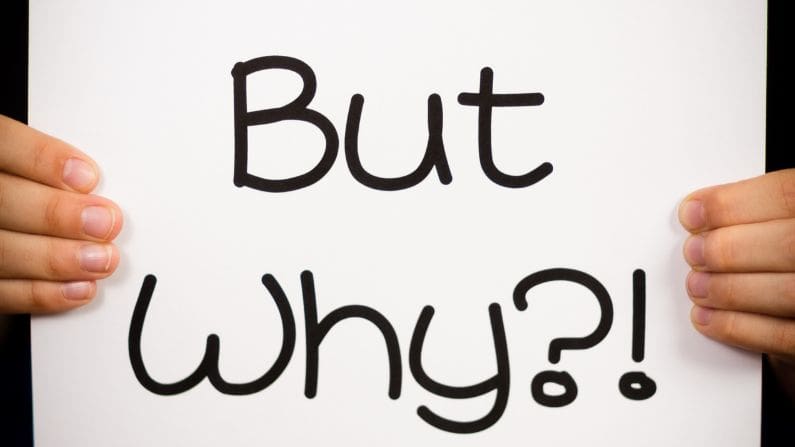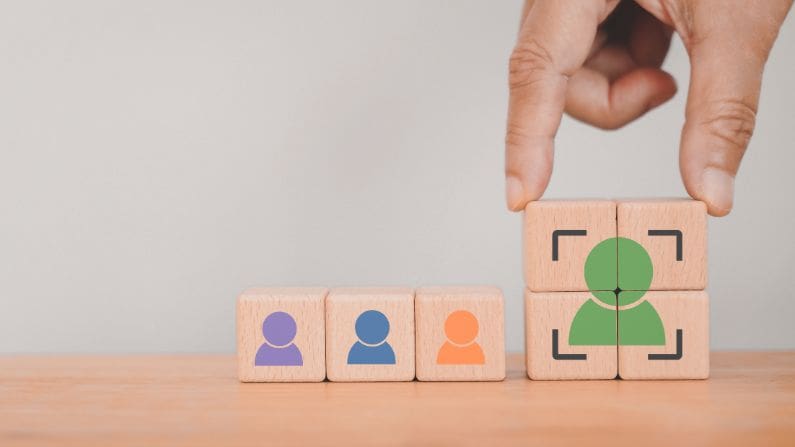Marketeering Blog
Why Your Business Needs a Buyer Persona

Aany businesses market to the masses hoping that a few will take the reins and become a customer. Targeting the ideal customer is a cost-effective and much more efficient way of getting more customers. How do you do that? Developing a buyer persona can help you streamline your marketing and advertising and increase leads and paying customers, and ultimately, your profit margin.
What is a Buyer Persona?
A buyer persona – aka a customer persona, marketing persona, or customer avatar – is a semi-fictional representation of a company’s ideal customer, based on market research and real data about your existing customers. It includes details like demographics, behavior patterns, how customers spend, marital status, purchasing habits, motivations, and goals.
This concept helps businesses understand and relate to their target customer in a meaningful way, enhancing their marketing and sales strategies. That’s what makes buyer personas important.
Why Do I Need a Buyer Persona?

Having a clear understanding of the buyer persona enables a business to create tailored content create marketing messages, and tailor content so you can zero in on that target customer that will help resonate with your target audience, leading to stronger connections, improved customer loyalty, and of course, increased sales.
Targeting Your Ideal Customer
A buyer persona is really about targeting the person who would likely buy your product or service so you can tailor your marketing efforts. If you know who your ideal customer is and what they expect and are looking for, you can then laser focus your sales, product, and marketing strategies to target that specific type of ideal customer.
B2C vs. B2B Buyer Personas
In the realm of marketing, understanding your buyer persona is crucial, regardless of whether you’re operating in a B2C or B2B environment.
B2C buyer personas typically represent individual consumers. Their preferences are often influenced by personal factors like age, lifestyle, interests, and income. Marketers aim to appeal to these consumers emotionally, enticing them with products or services that fulfill personal needs or aspirations.
On the other hand, B2B buyer personas usually embody entire organizations or departments. The decision-making process in a B2B scenario is more complex and involves more stakeholders.
These buyers are largely driven by logic and potential ROI, seeking solutions that will enhance efficiency, cut costs, or drive growth for their business. Therefore, B2B marketing should be more focused on demonstrating the value and functionality of the product or service.
B2C Buyer Persona
Let’s say you own a high-end women’s clothing shop. You wouldn’t just market to the masses. You would want your efforts tailored to women who would likely come into your shop – a high-income professional.
B2B Buyer Persona
Or, maybe you’re a B2B business that installs and services computer systems to other businesses. You wouldn’t be marketing to an individual, you would target your strategies to businesses only.
A buyer persona will help your marketing and sales teams created targeted marketing campaigns by better understanding what your customers expect.
Multiple Buyer Personas

Depending on your business, you may need multiple buyer personas so that you can effectively target different prospective customer segments. Each buyer persona represents a distinct group or individual potential customer with unique needs, challenges, and preferences.
For instance, in a software company, one persona might be a tech-savvy IT manager looking for efficient solutions, while another could be a non-tech business owner valuing simplicity and customer support.
By understanding the distinct needs and challenges of each buyer persona, your marketing strategies can be more fine-tuned, ensuring that your messaging resonates and engages existing and potential customers effectively.
Having multiple buyer personas is an integral part of customer segmentation and personalized marketing.
Related: Remarketing Your Potential and Existing Customers
Buyer Persona Examples
Here are a few examples of buyer personas. Remember, these are semi-fictional representations based on your real customer data and market research. The buyer’s personal story should serve as a tool to help your business understand and relate to your target market.
Marketing Molly
Molly is a 30-year-old marketing manager who has been in the industry for 5 years. She is tech-savvy, constantly striving to stay ahead of marketing trends and looking for innovative ways to reach her company’s target audience. She values quality content that gives her actionable steps she can implement in her marketing strategy.
Entrepreneur Eric
Eric is a 40-year-old founder of a startup. He has a hands-on approach towards his business and is always seeking advice and resources to grow his company. Eric values time efficiency and looks for solutions that can help him streamline his operations.
Stay-at-home Sarah
Sarah is a 35-year-old stay-at-home mom who loves finding the best products for her family. She spends a lot of time researching products online before making a purchase decision. Sarah values quality and reliability in products and appreciates businesses that offer excellent customer service.
IT Ian
Ian is a 45-year-old IT manager at a mid-sized enterprise. He has over 20 years of experience in the IT industry and is driven by the need to implement the latest tech solutions to solve business challenges. Ian prefers products that seamlessly integrate with existing systems and are user-friendly.
Executive Emily
Emily is a 50-year-old C-level executive in a large corporation. She values strategic insights and data-driven solutions that can improve operational efficiency and increase profitability. Emily appreciates concise, high-level summaries and case studies demonstrating ROI when considering new business solutions.
Procurement Peter
Peter is a 38-year-old procurement manager in a manufacturing company. Peter is continually looking for cost-effective and reliable suppliers and products. Peter appreciates detailed product specifications, transparent pricing, and strong customer support.
B2B Buyer Personas
These B2B buyer personas give insights into the needs and challenges of your ideal customers in a business-to-business context. It’s important to note that each B2B buyer persona represents a unique segment of your customer base and should be addressed with tailored marketing messaging and content.
Related: Should Your Business Be Using Sales Enablement
Create a Buyer Persona

Creating a buyer persona involves a multi-step process that includes market research, data analysis, and customer interviews.
- Research Your Audience: The first step in creating a buyer persona is to conduct thorough research about your target customers. This includes looking into your existing customer base, market research, competitor analysis, and industry trends.
- Analyze Customer Data: Analyze data from your existing customers. Look at their behavior patterns, preferences, and feedback. Use tools like Google Analytics, social media insights, and CRM data for this step.
- Conduct Interviews: Interviewing your customers can provide deep insights into their needs, preferences, and motivations. Ask about their experiences with your product or service, their goals, and their decision-making process.
- Identify Common Characteristics: After gathering all the data, look for common characteristics among your customers. This could be demographic details, interests, challenges, or goals.
- Create a Persona Profile: Once you’ve identified the common traits, create a detailed profile of your buyer persona. This includes their name, occupation, age, pain points, and motivations.
Remember, buyer personas are not set in stone. They should evolve along with your business, products, market trends, and, most importantly, your customers’ needs. Regularly reviewing and updating your personas will ensure that your marketing efforts remain focused and impactful and help with you marketing campaigns.
Buyer Persona Profiles
Creating buyer persona profiles involves a deeper understanding of your customer base, their behavior, and what your ideal customer prefers. Let’s take a look at the creation of two different buyer persona examples:
- Digital Dave
Dave is a 28-year-old digital marketer who has been working in a fast-paced technology startup for 3 years. In his role, he’s always on the lookout for creative ways to promote his company’s products online. He’s tech-savvy, often the early adopter of new digital tools and social media platforms. Here’s how we created Digital Dave:
Research: We found that a significant portion of our customer base are young professionals working in digital marketing roles, particularly in start-ups and tech companies.
Data Analysis: Our data showed that these customers were tech-savvy, appreciated our product’s innovative features, and regularly used our product’s integrations with other digital tools.
Interviews: We interviewed several customers fitting this profile. They shared that they were always on the hunt for the latest digital trends and tools to help them excel in their roles. They also mentioned that they appreciated quick and efficient customer service, as they usually work with tight deadlines.
Common Characteristics: The common traits among these customers were their age group (mid to late 20s), their role (digital marketers), and their workplace (start-ups or tech companies). They also valued innovation, efficiency, and excellent customer service.
Digital Dave Persona Profile:
- Name: Digital Dave
- Age: 28
- Occupation: Digital Marketer at a tech start-up
- Characteristics: Tech-savvy, innovative, values efficiency
- Pain Points: Keeping up with the ever-changing digital landscape, working with tight deadlines
- Motivations: Staying ahead of digital trends, finding efficient tools to help with his tasks
This buyer persona will guide product development, marketing, and sales strategies to better cater to Digital Dave’s needs, preferences, and pain points.
- Entrepreneur Emma
Another example buyer is Emma is a 32-year-old founder of a small online boutique. She has a keen eye for trends and a passion for promoting sustainable fashion. She’s focused on growing her business and is always seeking practical solutions that can help her manage her operations effectively. Here’s how we created Entrepreneur Emma:
Research: We began by analyzing our customer database, looking at patterns in buying behavior, preferences, and feedback. Additionally, we studied market trends and competitors in the sustainable fashion industry.
Data Analysis: We analyzed data from various sources – our e-commerce platform, social media insights, customer feedback, and Google Analytics. We were able to identify a segment of customers who were interested in sustainable fashion and owned small businesses.
Interviews: We conducted interviews with customers who fit into this segment. We asked about their motivations for buying sustainable fashion, their challenges in running an online boutique, and their decision-making process.
Common Characteristics: From the data gathered, we identified common characteristics. These included an interest in sustainable fashion, owning a small business, and seeking effective business solutions.
Persona Profile: With the common traits identified, we created Entrepreneur Emma, a persona that encapsulates these characteristics – her passion for sustainable fashion, her focus on growing her small business, and her search for practical solutions to help manage her operations effectively.
Entrepreneur Emma Persona Profile:
- Name: Entrepreneur Emma
- Age: 32
- Occupation: Founder of a small online boutique
- Characteristics: Passionate about sustainable fashion, driven, always seeking practical business solutions
- Pain Points: Managing operations effectively, keeping up with sustainable fashion trends, finding business growth opportunities
- Motivations: Growing her boutique, promoting sustainable fashion, finding practical and cost-effective business solutions
This buyer persona is a guide to understanding the needs, preferences, and challenges of small business owners like Emma. It helps in tailoring product development, marketing, and sales strategies to effectively target and serve this customer segment.
It’s important to remember that buyer personas profiles like Entrepreneur Emma and Digital Dave are tools to help your business better understand and connect with your target audience. By understanding their needs and challenges, you can tailor your products and marketing efforts to better serve them. Review and update these buyer personas regularly to keep your strategies effective and relevant.
Related: Using Technology to Market Your Business
The Four Types of Buyer Personas

Buyer personas can be classified into four main types:
- Demographic Persona: This type is often the starting point for creating buyer personas. It is based on demographic information such as age, gender, location, and income. For example, Digital Dave falls under this category as characteristics such as age, occupation, and workplace are considered.
- Behavioral Persona: This persona type is built around the customer’s behavior related to your product or service. This includes their purchasing habits, product usage, and brand interactions. Entrepreneur Emma would fit into this category with her specific interests and buying behaviors in relation to sustainable fashion.
- Psychographic Persona: This persona focuses on the customer’s lifestyle, values, personality, attitudes, and interests. It delves deeper into the emotional and psychological aspects of customer behavior.
- Needs-Based Persona: This type of persona is formed around the specific needs and pain points of your customers. It involves understanding the problems your customers are trying to solve and how your product or service fits into that solution.
Each type of persona serves its purpose and can provide valuable insights. Often, companies will use a combination of these different types to create comprehensive, detailed buyer personas that effectively guide their marketing and product development strategies.
How to Create a Buyer Persona Template
Creating a buyer persona template can ensure that you consistently gather and analyze the same relevant information for each persona.
Follow these steps to establish a template for creating your own buyer personas:
- Demographic Information – Start by defining basic demographic details such as age, gender, education level, and job title. This helps in creating a general profile for your persona.
- Professional Information – Include details about their profession like industry, job role, and their level of experience.
- Personal Information – Insights about your persona’s personal life can also be very valuable. Consider including information about their lifestyle, hobbies, and personal values.
- Goals and Challenges – Identify their professional and personal goals, as well as the challenges or obstacles they face in achieving those goals.
- Buying Behavior – Understand your prospective customers buying patterns, decision-making process, and what influences their buying decisions.
- Pain Points – These are specific problems that the buyers face which your products or services can solve.
- Preferred Channels of Communication – Identify where they prefer to get their information, whether it’s through email, social media, or industry-specific publications.
Your template should be a guide rather than a rigid format. Feel free to adapt and expand it to suit your specific needs. Remember, the goal is to create a tool that helps you better understand your customers, their needs, and how you can meet those needs effectively to reach your potential customers.
Creating Your Marketing Strategy

Now that you have your buyer persona profiles created, it’s time to develop your marketing plan based on what you learned about your ideal customer.
To create an effective marketing program, begin by defining your primary marketing objectives that align with your business goals. These objectives should reflect the needs and desires of your buyer persona.
Marketing Platforms
Next, determine the best platforms and channels to reach your buyer persona. Consider their preferred social networks, the websites they frequent, and the type of content they consume.
Then, craft your marketing messages, ensuring they resonate with your buyer persona’s pain points, needs, and aspirations.
Finally, set KPIs to measure the success of your strategy, such as lead generation, conversion rates, and customer retention. Remember, your marketing strategy should be fluid, allowing you to adjust and adapt based on feedback and data from your buyer persona’s engagement.
It’s Like a 3-Act Play
Understanding the buyer’s journey is crucial for effective marketing. The buyer’s journey is a fundamental part of your customer’s experience, documenting the path they take from their initial contact with your brand to the ultimate decision to purchase.
The journey typically consists of three stages:
- Awareness: This is the first stage where the buyer realizes they have a problem or a need. They start looking for information and solutions, and this is where they first come into contact with your brand.
- Consideration: In the second stage, the buyer has clearly defined their problem and is now exploring various solutions. They’re comparing different products or services and deciding which one suits their needs best.
- Decision: The final stage is where the buyer chooses a solution. They’ve evaluated all their options and are now ready to make a purchase.
Guiding Your Customer
Remember, you are the guide for your customer that will lead that person through their buying or customer journey – also known as the sales funnel. It’s like a three-act play – a three-phased marketing approach that:
- Leads the customer from becoming aware of your business that is offering the service or product they want to:
- Providing content and messaging to show them you are the solution to their problem.
- And finally, turning that potential customer into a paying customer.
Here is a breakdown of how you would use that three-phased approach to develop your marketing plan for Digital Dave and Entrepreneur Emma:
Awareness: This is the stage where Digital Dave and Entrepreneur Emma are first learning about your product or service. In this stage, they are likely experiencing a problem or a need, and are researching to understand it and find solutions. Your role is to provide informative content that helps them gain a clear understanding of their problem and introduces them to your brand. This content could be blog posts, social media posts, infographics, or webinars.
Consideration: At this stage, Dave and Emma are evaluating different options to solve their problem or fulfill their need. They are looking for a solution that caters to their specific pain points and needs. Your content should highlight the unique value propositions of your product or service, showcasing why it’s the best solution for them. This can be done through case studies, demo videos, or detailed product descriptions.
Decision: This is the final stage, where Dave and Emma are ready to make a purchasing decision. They have shortlisted their options and are looking for further validation to make that final choice. Your role here is to reassure them that your product or service is the right choice. You can do this through customer testimonials, discounts or offers, and personalized communication.
Tailoring Your Marketing Message
Understanding your buyer’s journey can help you tailor your marketing program and content to meet your customers’ needs at each stage, guiding them smoothly from awareness to decision. This ensures that you are providing the right content at the right time to your potential buyers. It’s an effective approach to convert potential customers into actual buyers.
Buyer Journey and Buyer Persona
While understanding the buyer’s journey is crucial, aligning it with the buyer persona is what makes your marketing plan more effective.
For instance, let’s take Entrepreneur Emma. She may be in the awareness stage, where she’s just starting to realize she has a need for your service. In this case, your content should introduce your brand and present the problems your service solves.
On the other hand, Digital Dave might be in the decision phase, having evaluated various options and just about ready to make a purchase. For him, testimonials or a personalized offer could be the final push he needs to choose your service.
Tailoring your approach to each persona’s stage in the buying cycle ensures that you are meeting their specific needs and making them feel understood and valued. This strategy not only increases the likelihood of purchase but also boosts customer loyalty and satisfaction.
Related: B2B Marketing Strategies
Let Metro Annex Help with Your Buyer Personas
In the rapidly evolving digital landscape, creating accurate buyer personas and aligning them with a tailored marketing plan can be complex. That’s where Metro Annex Interactive comes in.
A Professional Team
We have a team of dedicated professionals who are well-versed in comprehending audience behavior, crafting precise buyer personas, and formulating marketing strategies that resonate with them.
We dive deep into your customer database, competitor analysis, and industry trends to understand the unique nuances of your target audience. Our comprehensive approach ensures we create buyer personas like “Entrepreneur Emma” and “Digital Dave” that accurately represent your customers, their motivations, and their challenges.
Creating Your Marketing Plan
Leveraging these buyer personas, we can design a data-driven marketing program that effectively guides the customer journey, from awareness to the final purchasing decision.
We can work together to create a marketing plan that resonates with your audience and drives your business growth. Let Metro Annex Interactive be your marketing department.
Some material from Visme, SocialMediaToday, Upwork, and B2B International was used in this article.c
Article Resources
FAQ’s
What is a buyer persona and how does it differ from a business persona?
A buyer persona is a detailed profile of an ideal customer which represents a target segment for your business. While it shares similarities with a business persona, a buyer persona is often more focused on the purchasing behavior and decision-making process of potential customers.
Why is a buyer persona crucial for businesses?
A buyer persona is crucial because it helps businesses understand their customers on a deeper level, enabling them to tailor their marketing strategies, product development, and services to meet the specific needs and desires of different customer segments.
How can a buyer persona improve marketing strategies?
A buyer persona can improve marketing strategies by providing insights into the customer’s preferences, behaviors, and pain points, which allows for more targeted messaging, more effective use of marketing channels, and better alignment with customer needs.
What information is typically included in a buyer persona?
A buyer persona typically includes demographic details, behavioral traits, goals, challenges, preferred communication channels, and specific insights into the customer’s decision-making process.
Can buyer personas evolve over time, and how often should they be updated?
Yes, buyer personas can evolve as market conditions, consumer behaviors, and business objectives change. They should be reviewed and updated regularly, at least annually, to ensure they remain accurate and relevant.
FAQ’s
Author

Mathew Phillips | Digital Marketing Specialist
Mathew Phillips is an expert in digital marketing and lead generation services. Mathew has a passion for all things digital marketing from website design and search engine optimization to digital advertising, email marketing and social media.





